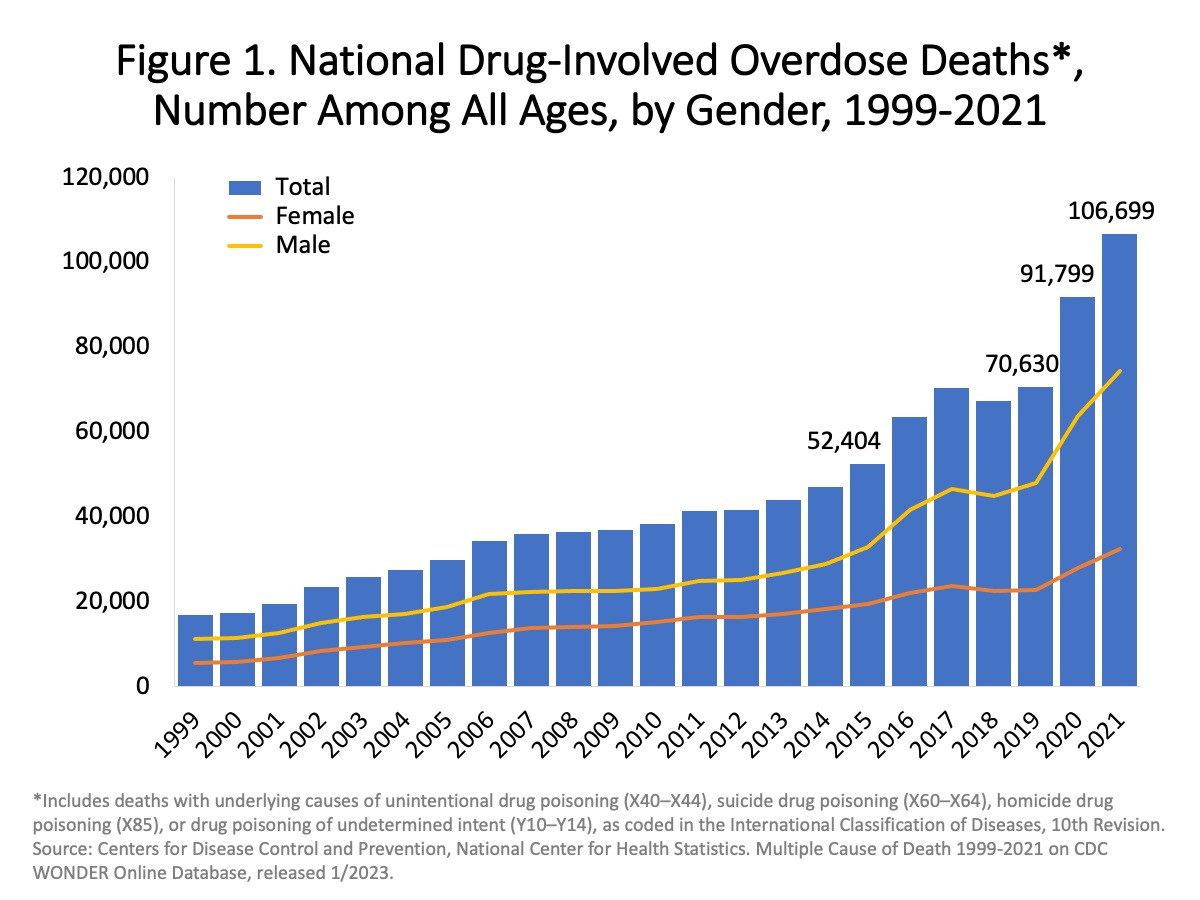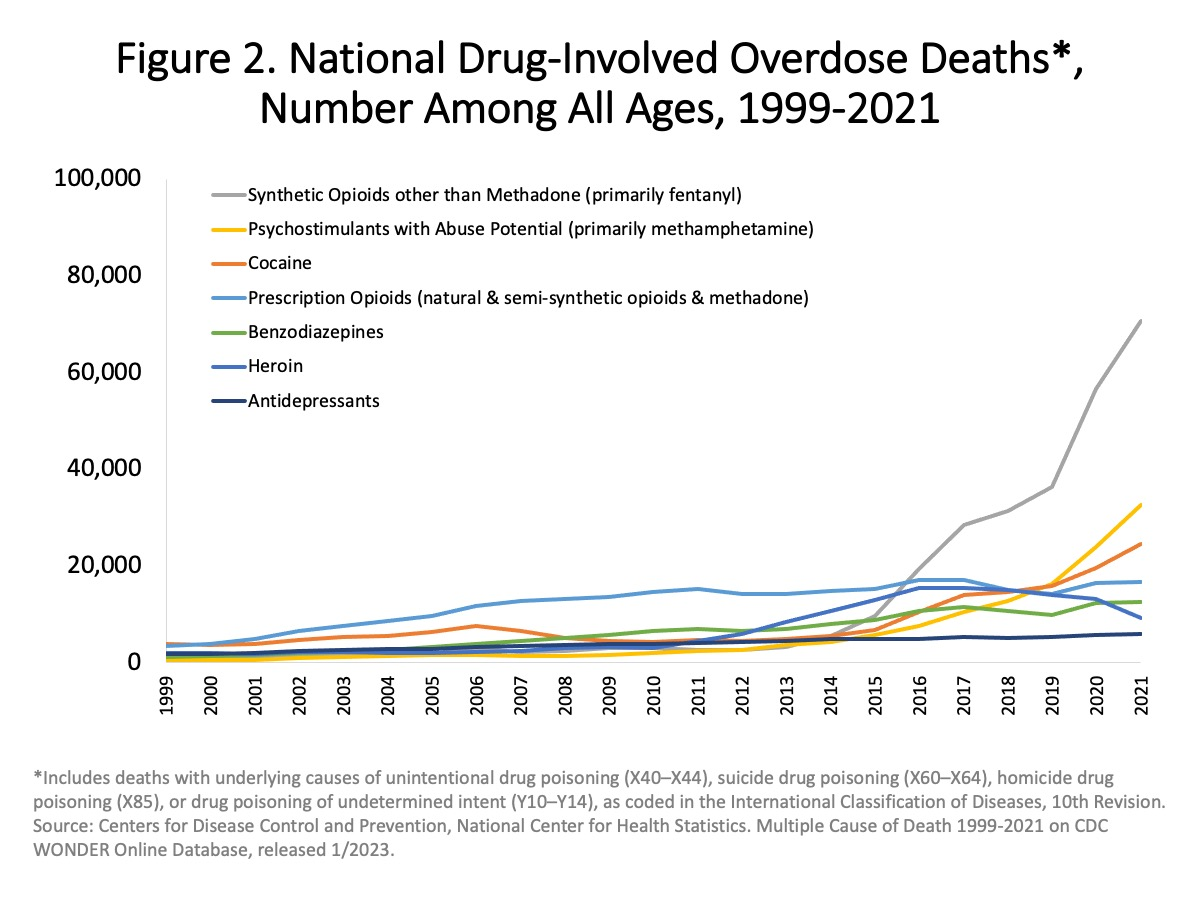US Drug Test Centers Blog
How Many People Die From a Drug Overdose Every Year?
Despite decades of warnings to the contrary, too many people still treat drugs and alcohol like they're nothing but a good time, leading to many deaths and countless lives affected. In this blog, we will be examining the number of overdose deaths over the last several years and what the trends have looked like over time. We'll also consider the most common drugs involved in overdose deaths, which groups of people are experiencing the most deaths involving drug use, and why overdose deaths seem to be getting worse over time.
Lastly, we'll consider what can be done to prevent more deaths due to drug overdose.
Drug Overdose Deaths by Year
The number of drug overdose deaths has fluctuated over time, but here are the estimates for the last several years:
2018: 67,367 overdose deaths
2019: 70,630 overdose deaths
2020: 91,563 overdose deaths
2021: 106,699 overdose deaths
2022: 107,941 overdose deaths
2023: 112,000 overdose deaths
Drug Overdose Deaths by Age
The number of drug overdose deaths varies based on the age group. For instance, yearly estimates consistently show that people between the ages of 25 and 44 years are likelier to die from a drug overdose.
On the other hand, people between the ages of 15 and 24 years and 65 years and older are least likely to die from a drug overdose.

Is it Worse for Men or Women?
Interestingly, males are more likely to die from a drug overdose than females, according to estimates from the Centers for Disease Control and Prevention (CDC). For example, research has found that men are two to three times likelier to experience a drug overdose from opioids (like fentanyl and heroin), as well as psychostimulants (like cocaine and methamphetamine).
This is because, first and foremost, men typically use illicit substances more than women, and they also abuse them more than women. But there are other biological, behavioral, social, and gender-related factors at play. For example, men are more vulnerable to the toxicity of drugs, compared to women.
Which Drugs Are Most Commonly Responsible for Overdose Deaths?
There are indeed some startling patterns and trends when it comes to which specific drugs are behind many of the fatal overdoses the United States is seeing.
Opioids — and more specifically, synthetic opioids — are currently the main driver and have seen a sharp increase over the years. (Examples of synthetic opioids include methadone, tramadol, and fentanyl.) In fact, the CDC estimates that in 2021 alone, opioids were involved in 75.4% of all drug overdose deaths, which is equivalent to about 80,411 fatalities. And of those fatalities, almost 88% involved synthetic opioids. Deaths by prescription opioids, however, seem to be holding steady.
While synthetic opioids are very often involved, other substances are becoming more prominent in drug overdose deaths. Psychostimulants like methamphetamine are seeing an increase, regardless of whether or not synthetic opioids are involved. Drug overdose deaths involving cocaine are also growing.

Why Are Drug Overdose Deaths Increasing?
Why do drug overdose deaths just seem to keep getting worse? There are a few explanations around the underlying cause.
There was first a sharp increase in the 1990s, according to the CDC, because more healthcare providers were prescribing opioids to their patients. Providers and researchers initially underestimated just how addictive these drugs are, and that was why opioid overdose started becoming so much more prominent.
Then, around 2010, the number of drug overdose deaths involving heroin saw a rapid increase. Providers had to start pulling back on the opioid prescriptions that they were handing out to patients, and individuals who were addicted sought out that same high through other means. Illicit opioids like heroin are more accessible and cheaper, helping explain why more people have turned to this drug.
Another increase was observed in 2013, again involving synthetic opioids like fentanyl. Alongside fentanyl, more people also started using heroin, cocaine, and counterfeit pills.
The Impact of the COVID-19 Pandemic
The COVID-19 pandemic created yet another jump in drug overdose deaths, but why?
During lockdown, access to care for those dealing with substance use disorder became harder to come by. People weren't getting the treatment and resources they needed.
Furthermore, having to isolate at home wasn't exactly great for America's mental health. In the first year of the pandemic, depression and anxiety around the globe increased by 25%, according to data from the World Health Organization (WHO). People were lonely, stressed, and struggling. While the suicide rate remained stable (although youth suicide rates, specifically, increased), more people thought about and attempted suicide during the pandemic.
What's Being Done About the High Number of Drug Overdose Deaths in the US?
The US Department of Health and Human Services calls these deaths a national public health emergency. So, what can we do about it?
To target opioid overdose specifically, the Department of HHS calls for more attention on naloxone, which can reverse opioid overdose and thus prevent death. This means increasing access to naloxone and offering more evidence-based treatment for substance use disorder.
In general, the HHS looks at decreasing overdose deaths via four pillars:
Primary prevention: Prevention should be aimed at high-risk individuals who need help managing pain while reducing the clinically inappropriate prescribing of drugs that have a higher substance abuse potential.
Harm reduction: This might mean developing more educational materials and programs to reduce the stigma around drug use and treatment.
Evidence-based treatment: The main focus should be eliminating any and all barriers to treatment, ultimately improving engagement and retention.
Recovery support: Treatment is a start, but we have to widen our approach. We must enable access to and encourage treatment, in addition to improving the quality of treatment and care.
Reliable and Thorough Drug Testing
Drug testing is also crucial to reduce drug overdose fatalities in our families and communities. Employers should consider workplace drug screening to discourage employees from abusing substances while on the clock.
Parents can also utilize drug testing if they're concerned that their child is participating in substance use.
With a proactive approach and equal access to prevention, treatment, education, resources, and rehabilitation, we can reduce both fatal and nonfatal overdoses in the United States.
























